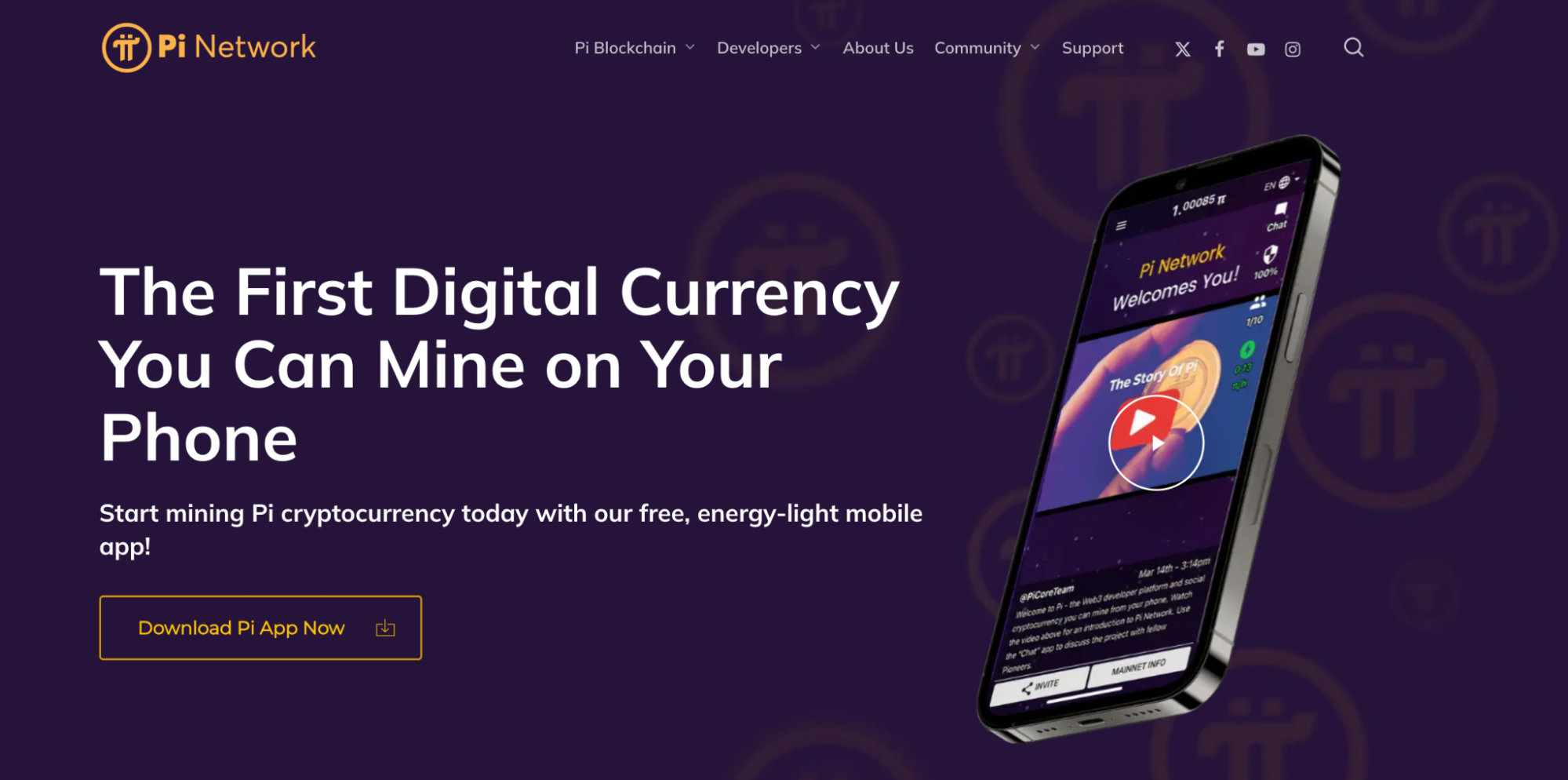¿Cuánto es 1000 Pi en Euros? Guía de valoración y conversión de 2025 Pi Coin
1. Visión general del Proyecto Pi Network
Pi Network es un proyecto de criptomoneda creado en 2019 por un equipo de doctorados de Stanford, con el objetivo de hacer que la minería de criptomonedas sea accesible para todos a través de teléfonos móviles. Su lema, “la primera moneda digital que puedes minar en tu teléfono”, enfatiza su fácil incorporación a través de una aplicación móvil gratuita y liviana. A diferencia de las blockchains tradicionales, Pi adopta un algoritmo de consenso de Tolerancia a Fallas Bizantinas, utilizando un gráfico de confianza distribuido para garantizar la seguridad. Los usuarios (llamados “Pioneros”) simplemente hacen clic en un botón a diario para recibir recompensas de Pi. El proyecto fue fundado por los doctorados de Stanford Nicolas Kokkalis y Chengdiao Fan, entre otros, con la visión de construir un ecosistema descentralizado que involucre a decenas de millones de usuarios cotidianos al reducir las barreras de entrada a las criptomonedas.

Fuente:Red de Pi
2. Antecedentes y Mecanismo de Suministro de Pi Coin
Como el token nativo del ecosistema de la Red Pi, la emisión de Pi Coin es fundamentalmente diferente de los tokens tradicionales de ICO. En lugar de ser ofrecidos a través de recaudación de fondos pública, las monedas Pi han sido adquiridas gradualmente por los usuarios a través de la minería móvil desde 2019. Cuando la Red Pi lanzó su mainnet, pre-minó 100 mil millones de monedas Pi como la oferta máxima teórica. De este total, el 65% (65 mil millones) fue asignado a la comunidad como recompensas de minería, el 20% (20 mil millones) al equipo central, el 10% reservado para la fundación, y otro 5% para fines de liquidez para apoyar el desarrollo del ecosistema. Es importante tener en cuenta que la cifra de 100 mil millones es un límite, la oferta circulante real depende de la producción minera de los usuarios y la migración.

Fuente:Coinmarketcap
Pi Network utiliza un modelo de producción minera gradualmente decreciente. Los usuarios tempranos disfrutaron de tasas de minería más rápidas, las cuales disminuyen exponencialmente a medida que el suministro total de monedas Pi de la red se acerca al límite. Además, solo se considera parte del suministro circulante el Pi que ha pasado por verificación KYC y ha sido migrado a una billetera de mainnet. Dado que muchos usuarios aún no han pasado la verificación KYC, el volumen real de monedas Pi migradas en cadena es significativamente menor que la producción teórica.
A principios de 2025, el suministro total efectivo en la red principal de Pi (extrapolado según la cantidad de Pi migrado y en circulación) es de aproximadamente 11 mil millones de monedas, con un suministro circulante real de alrededor de 6.9 mil millones. En comparación con el suministro máximo de 100 mil millones, esto sigue siendo muy bajo, lo que sugiere que el suministro podría seguir aumentando a medida que más usuarios completen el KYC y migren su Pi a la red principal. Sin embargo, algunos usuarios pueden abandonar el proceso KYC o permanecer inactivos durante períodos prolongados, lo que significa que una parte de Pi puede que nunca entre en circulación, reduciendo así el suministro efectivo.

Fuente:CoinGecko
Vale la pena señalar que la distribución de la moneda Pi enfatiza la equidad y la amplia participación. Todos los usuarios deben ser invitados para obtener calificaciones de minería y se les pide que formen un "Círculo de Confianza" dentro de la red para mejorar su seguridad. Cuantos más nuevos miembros invite un usuario, mayor será su tasa de minería (recompensas de "Embajador"). Este mecanismo de referencia multinivel ha generado algunas preocupaciones y ha sido malinterpretado por algunos como un esquema piramidal. Sin embargo, el equipo de Pi aclara que este modelo está diseñado puramente para fomentar el crecimiento de la comunidad y garantizar la construcción de la red, sin necesidad de ninguna inversión financiera.
3. 1000 Pi en Euro: Conversión Actual y Lógica
Tras el lanzamiento de la mainnet en febrero de 2025 y la eliminación de las restricciones de red, Pi ahora se puede negociar libremente, con su precio de mercado determinado por la oferta y la demanda. Entonces, ¿cuánto es 1000 Pi en euros?
Según los datos más recientes a mediados de abril de 2025, el precio de 1 Pi es aproximadamente €0.56. Esta cotización en tiempo real proviene de intercambios y refleja el valor de mercado del token. Con este precio unitario, calcular el valor en euros de 1000 Pi es sencillo:
Valoración actual: 1 Pi ≈ €0.56
Por lo tanto, 1000 Pi ≈ €560
Esto significa que, al precio de mercado actual, convertir 1000 Pi produciría aproximadamente €560. Esta es la respuesta directa a '1000 Pi en Euro'.

Fuente:Gate.com
Sin embargo, el precio de Pi está sujeto a volatilidad. Desde que la mainnet se abrió para negociar, Pi ha experimentado fluctuaciones significativas. El 20 de febrero, durante las primeras horas de negociación, Pi subió a casi $2.00 (≈€1.85), antes de caer rápidamente a alrededor de $1.00.
Aquí hay una tabla simulada que muestra el rango de valor potencial de 1000 Pi en diferentes puntos de precio:

La tabla anterior ilustra el rango de valoración aproximado de 1000 Pi en euros, desde escenarios pesimistas hasta optimistas. Al precio actual, 1000 Pi vale un poco más de €500. Si Pi sube a €1, entonces 1000 Pi equivaldría a €1000. En un escenario ultra alcista donde Pi se dispara a €10, 1000 Pi valdría €10,000.
Por supuesto, son posibles resultados más pesimistas, por ejemplo, si el precio cae a €0.10, entonces 1000 Pi valdrían un poco más de €100. Estos escenarios no son pronósticos de precios, sino que están destinados a ayudar a los lectores a comprender el valor de 1000 Pi en diferentes niveles de precios. El rendimiento real del mercado está influenciado por una variedad de factores, que exploraremos a continuación.
4. Factores que Influyen en el Precio de Pi
El precio de mercado de las monedas Pi no solo determina el resultado de conversión de 1000 Pi en euros, sino que también refleja las expectativas del mercado para el proyecto de la Red Pi. Desde que comenzó a operar, el precio de Pi ha sido influenciado por múltiples factores:
Progreso de la mainnet e implementación del ecosistema: La apertura de la mainnet marca el punto de partida para la realización del valor de Pi Coin. En la práctica, cada hito importante logrado por la Red Pi impacta en el sentimiento del mercado. Por ejemplo, cuando se anunció la fecha de lanzamiento oficial del 20 de febrero de 2025, se informó que el precio fuera del mercado de Pi aumentó aproximadamente un 80% (de alrededor de $0.5 a $0.9). Por el contrario, durante el 6º aniversario de la Red Pi en marzo de 2025 (Día Pi), el equipo introdujo características como subastas de dominios .pi y el festival de compras PiFest, pero la respuesta del mercado fue relativamente tranquila, y el precio de Pi en realidad disminuyó. Esto indica que la utilidad real y la demanda deben materializarse para que las noticias positivas respalden efectivamente el precio de la moneda.
Dinámica de Oferta y Demanda: El modelo de emisión único de Pi lleva a liberaciones de suministro en fases. Al inicio de la fase de red abierta, alrededor de 6.9 mil millones de Pi entraron en circulación. A medida que más usuarios completan el KYC, se espera que el suministro circulante aumente. Esto significa que la presión de venta potencial se está liberando gradualmente, algunos primeros adoptantes acumularon miles o incluso decenas de miles de Pi y ahora pueden optar por liquidar porciones de sus tenencias después de la red principal, aumentando la presión de oferta. Esta fue una de las razones clave de la continua caída de precios en las semanas posteriores a la apertura de la negociación en febrero. Sin embargo, un aumento en el suministro no necesariamente implica devaluación a largo plazo, ya que la creciente comunidad de Pi también atrae a nuevos compradores e inversores, contribuyendo a la creciente demanda.
Confianza y expectativas de la comunidad: Pi Network tiene una comunidad global masiva, y muchos "Pioneros" tienen confianza a largo plazo en el valor de la moneda. Esta creencia colectiva de la comunidad actúa como una forma de soporte suave para el precio. Recientemente, las discusiones de la comunidad en torno a los calendarios de desbloqueo de la red principal y los lanzamientos de proyectos del ecosistema han sido animadas, lo que refleja expectativas más amplias para el valor a medio y largo plazo de Pi.
Entorno Macro y Competencia: Como proyecto de blockchain de Capa-1, Pi Network también se ve afectado por las condiciones del mercado más amplio. Entre 2022 y 2023, el mercado de criptomonedas experimentó una volatilidad significativa, y los cambios en el apetito de riesgo de los inversores pueden afectar a las monedas recién listadas como Pi. Si criptomonedas principales como Bitcoin entran en una tendencia bajista, Pi también puede estar bajo presión. Además, otros proyectos de airdrop a gran escala (como SafeMoon) han experimentado ciclos de auge y caída, lo que lleva al mercado a considerar los riesgos potenciales para Pi en función de comparaciones históricas. Por otro lado, si Pi Network puede establecerse en el competitivo espacio de blockchain público (donde existen ecosistemas maduros como Ethereum, BSC y Solana) y demostrar una fuerte conversión de valor para los usuarios, la confianza de los inversores aumentará significativamente, ofreciendo el potencial de una revaluación.
En resumen, el precio de Pi está determinado por muchos factores interrelacionados. Para los titulares preocupados por el valor de "1000 Pi en Euro," es crucial monitorear los desarrollos del proyecto de la Red Pi, los cambios en la oferta y la demanda, y las tendencias más amplias del mercado de criptomonedas. Los inversores racionales deberían considerar tanto los fundamentos como el sentimiento del mercado, en lugar de depender únicamente de rumores de la comunidad o impulsos emocionales.
5. Guía del usuario: Cómo obtener Pi y usar su valor
Para los recién llegados y lectores interesados en la Red Pi, una pregunta común es: ¿Todavía hay oportunidad de participar en Pi ahora? ¿Cómo se pueden obtener monedas Pi y cómo se puede utilizar mejor el valor de 1000 Pi en Euros? A continuación se presentan algunas pautas útiles:
La forma más fundamental de obtener monedas Pi sigue siendo a través de la minería mediante la aplicación oficial. ActualmenteAplicación de la red PiLa aplicación de Pi Network está disponible para su descarga gratuita en las principales tiendas de aplicaciones móviles. El registro requiere un código de invitación (que se puede obtener de los miembros de la comunidad existente). Después de registrarse y completar la verificación del número de teléfono o de Facebook, los usuarios pueden comenzar a minar como un “Pionero.”
Comprar monedas Pi a través de un intercambio: Si no desea esperar el largo proceso de minería, o desea mantener Pi inmediatamente para invertir en el mercado, también puede optar por comprar directamente monedas PI en el intercambio Gate.com, para obtener más información, consulte Gate.com Compra PI TutorialVale la pena mencionar que obtener monedas Pi a través de plataformas importantes como Gate.com no solo es rápido y confiable, sino que también proporciona la información más reciente y recordatorios de mercado, lo cual es muy útil para comprender los cambios en el valor de 1000 Pi en euros.
Si no quieres esperar a través del largo proceso de minería o quieres mantener Pi inmediatamente para invertir en el mercado, puedes elegir comprar monedas PI directamente en el intercambio Gate.com. Para obtener más detalles, consulta el tutorial de compra de PI en Gate.com. Vale la pena señalar que adquirir monedas Pi a través de plataformas importantes como Gate.com no solo es rápido y confiable, sino que también proporciona acceso a las últimas noticias y alertas de precio, lo que te ayuda a mantenerte informado sobre el valor cambiante de 1000 Pi en euros.
-Mientras disfrutas de los beneficios que trae la Red Pi, es igualmente importante no pasar por alto la educación sobre el riesgo. Dado que la Moneda Pi todavía está en las primeras etapas de descubrimiento de precios, es altamente volátil, y el valor de tener 1,000 monedas Pi puede experimentar fluctuaciones significativas a corto plazo.
Para un aprendizaje continuo, se recomienda visitar regularmente la sección de información de Gate.com, Gate Learn,Gate Learno el blog oficial de Pi Network para mantenerte actualizado sobre los últimos desarrollos del proyecto y perspectivas del mercado.
- Ahora que las monedas Pi son negociables, es esencial utilizar eficazmente las herramientas proporcionadas por las plataformas de negociación. Gate.com ofrece una variedad de funciones como alertas de precios, planes de inversión recurrente, servicios de staking y préstamos. También puedes utilizar tus tenencias de Pi en Gate.com para préstamos o productos financieros y así obtener intereses. Sin embargo, es importante revisar cuidadosamente los términos y riesgos potenciales de estos servicios.
En general, hacer un buen uso de las herramientas de intercambio puede ayudarte a gestionar y hacer crecer el valor de tus activos de Pi.
En conclusión, ya sea que estés acumulando Pi a través de la minería, comprándolo en un intercambio o usándolo para consumo y participación en el ecosistema, la clave es comprender a fondo el proyecto y mantener una mentalidad racional.
6. Conclusión
A través del análisis anterior, aprendimos que 1000 monedas Pi valen actualmente alrededor de 560 euros en el mercado, pero esta es solo la situación instantánea en abril de 2025. Las oportunidades vienen con riesgos, invertir en monedas Pi todavía requiere precaución, adquisición oportuna de información y elección de canales legítimos para el comercio. Como inversionistas experimentados en criptomonedas, le recomendamos descargar Aplicación oficial de Gate.comMantén un seguimiento de los precios de la moneda Pi en todo momento y asegura la seguridad en tus operaciones. A través de la aplicación de Gate.com, puedes establecer alertas de precio para aprovechar los momentos clave de cambios de valor de 1000 Pi; y utilizar los gráficos profesionales y la información proporcionada por la plataforma para hacer juicios profundos sobre las tendencias del mercado.
Además, si deseas aprender sistemáticamente conocimientos sobre blockchain y mejorar habilidades de inversión, puedes visitar Gate Aprender Plataforma de AprendizajeAccede a cursos de criptomonedas completos y los últimos informes de investigación. En resumen, comprende información y herramientas autorizadas, participa activamente en la construcción de la comunidad, para abrazar mejor el viaje de crecimiento de valor futuro de la Red Pi.
Artículos relacionados

Valor de los Blox Fruits: Cómo evaluar y maximizar el valor comercial de los Blox Fruits

Valor de Cripto PI: Lanzamiento en Mainnet el 20 de febrero de 2025 & Predicciones de precios futuros

¿Es XRP una Buena Inversión? Una Guía Integral sobre su Potencial

¿Cómo rastrear la transacción USDT BEP20?

Cómo vender Pi Coin: una guía para principiantes


